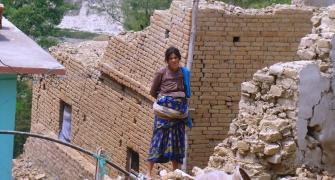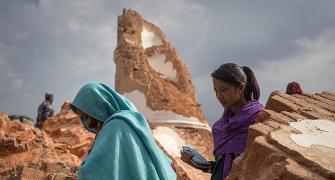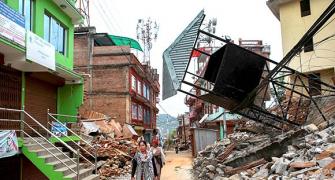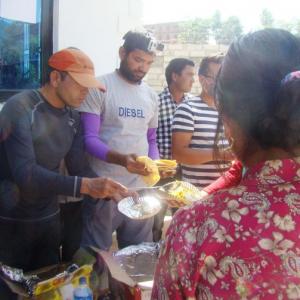Quake after quake continue to jolt the Himalayan nation. Aid is arriving in Nepal, but its far flung villages remain cut off, two weeks after the April 25 horror. Villagers live amid debris and the common compliant is: No one has come to check on us.
Anusha Subramanian reports from Dholakha district, 153 km from Kathmandu.

Mithai Ghising, 70, struggles to clear debris of her house in quake-hit Namdu village of Nepal’s Dholakha district, 153 km from Kathmandu. This she says was her "dream house" that she built after leaving her husband using up all her savings. Her struggles to fend for herself and a son Bhidayak appear dwarfed as she looks around with helpless eyes. The walls have developed huge cracks; the house is no longer safe but she has nowhere to go.
Ghising echoes the tales of thousands of others in Nepal who scramble to pick up the pieces after an earthquake of 7.8 rocked the Himalayan nation on April 25, leaving more than 8,000 dead.
Shyam Nepali 35, from the Dalit community works as a daily wage labourer around Dholkha district and earns a meager 400 Nepali Rupees a day. Seventeen days since the world around him came crashing, quite literally, he finds himself without a job, there’s no house to return to and barely any food to eat.
He says, “I cannot afford anything right now. I do not have any land. We leave each day as it comes. We have survived the earthquake, but what next? We will have to wait for relief.”
Ghising claims that the government relief has reached the office of the village development committee, but the desperate wait for the locals continues. “We are told we will get relief but, so far we have got nothing. We only need shelter over our head. We do not require food as of now,” she says.
“We received a few tarpolines from a Good Samaritan, but we need more so that everyone has a shelter over their head during the monsoons,” Nepali adds.

Namdu received Rs 2000, five packets of noodles and one kilo of rice per household after the quake. But, soon the village will run out of food supplies.
Namdu has nine wards with 1,739 houses of which 190 houses have been flattened and another 1,372 have been declared unsafe.
The story is no different in other far flung villages in Nepal or even worse. Driving through a steep winding dirt track, a muddy and narrow road leads up to the ruins of a small village of Khotgaon situated at a height of approximately 6,000 ft in the Jhanga Joli VDC (village development committee). Relief has trickled here and villagers are anxiously waiting for more. They say that no government official or for that matter no one has come and checked on them.
With no aid coming forward from the government, Joy Nepali, a young Dalit man who works for the US embassy in Kathmandu, takes it upon himself to help his villagers along with another friend Shibjan, an engineer from Sindhuli district. They contact Goonj, an Indian non-profit body, for supplies and organise their own vehicle to take relief material to their villages.
As soon as the vehicle carrying relief reaches Kothgaon, villagers, both adults and children, run towards it completely overwhelmed.

“There are many Dalit families in these villages that are extremely poor. We have only distributed rice and dal to those who have lost their houses and do not have food to eat -- old people and single women with children,” says Joy.
Clearly, aid has been slow in reaching those who need it most. In many places, it has not reached at all. Such is the plight of villages in Sinduli, Dholkha, Ramechap, Ruswa districts.
In some parts of Sindhuli, Ujjwal Thapa, a social activist, has been doing whatever is possible to arrange for supplies such as rubber mats, ration, clothes for old and children, blankets.
Thapa says, “Being helpless for almost 10 days after the quake, finally we are able to get relief across to people. Initially, I started on my own with some youngsters from the villages volunteering in distributing the supplies that I was getting from my friends in India.”
“Now, things are falling in place and I am working with the chief district office and the army to reach out to all the deserted villages. Finding volunteers to get to all these villages is also difficult.”

The CDO of Sindhuli has set up eight relief camps where villages which have not received any aid can register. “I will make sure that the supplies reach each and every house which was destroyed,” assures Thapa, who is also trying to get supplies across to other adjoining districts such as Ramechap, which has seen around 70 per cent destruction.
The agitated and frustrated villagers complain, “Just because our villages have not seen human casualties the relief here is slow.”
The government’s attention initially was focused on areas such as Gorkha and Sindhupal Chowk, where many were killed. In the process, they ignored remote villages. But, now it’s understood from sources that government’s relief operations have spread across affected areas and their aim is to get to as many as soon as possible.
“Villagers have to help themselves instead of waiting for relief to come to their doorstep,” says Thapa. The government has also been announcing on radio where relief camps have been set up and how the villagers can access it.
The challenge is that of also getting to these villages. Only small vehicles can go up to Nuwakot, Ruswa: Trisuli, Dhading, Sindhuli because of the condition of road. Moreover, caution needs to be adhered because of risk of new landslides.

Frustrations are mounting.
There are fewer men in the villages. The youth have moved Kathmandu or Malaysia and Gulf countries in search of employment. Those left behind are women, children and the old; they are petrified.
Sarita Ghising, working in Namdu’s primary health centre says, “Children have not been able to sleep. They are scared when their parents venture inside the damaged houses in search of their belongings.”
The army is making attempts to connect with these remote areas. "Nepal is a very small country; we have limited resources," says Brigadier General Jagadish Chandra Pokharel. (The Nepal army has 12 helicopters in all.)
"The terrain is inaccessible even under ideal circumstances. However, access to some remote villages remains a key challenge; they can only be reached by helicopters. We are unable to send the choppers because of bad weather and in some far flung places we have no choice but to send our soldiers on foot with relief," Brigadier Pokharel adds.
He assured that within the next few days, the army will be able to reach villagers in the remote areas. But, he says that they have exhausted their own war stock of tents and tarpolines.

NGOs such as Oxfam India and many international aid agencies have collaborated with several local organisations to provide relief supplies in the areas where no help has reached so far. Goonj, an Indian NGO has tied up with local NGOs such as Child Reach Nepal, Karuna Foundation Nepal to help out.
“Relief is reaching as far as possible thanks to enthusiastic groups of volunteers and local organisations,” says Anshu Gupta, founder director of Goonj, who is currently in Kathmandu and on ground overlooking the relief efforts. Goonj is providing from tarps, blankets, sacks of rice and dal and more.
The extent of the damage is humongous and many of the remote areas are still entirely cut off. The United Nation says the quake affected 8.1 million people -- more than a quarter of Nepal's 28 million population.
Government data as of May 11 shows that the earthquake killed 8,019 people and left 17,866 injured. Aftershocks are felt every day. Over 70 aftershocks have shook Nepal since April 25. And what’s made the situation worse is Tuesday’s multiple earthquakes.
But the villagers are keeping faith. They hold on to their hopes that aid will reach them soon. Their eyes fixed on the road looking out for a jeep full of relief.









